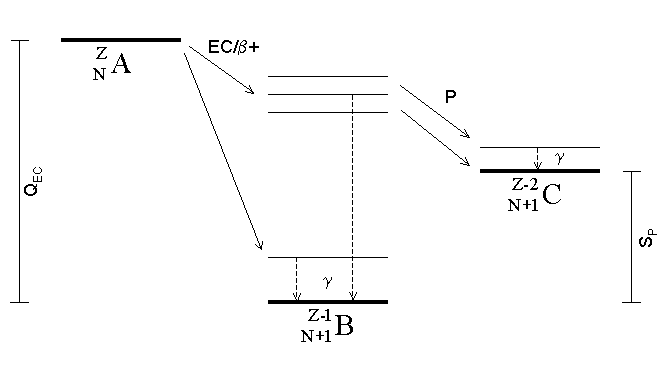Proton emission on:
[Wikipedia]
[Google]
[Amazon]
 Proton emission (also known as proton radioactivity) is a rare type of radioactive decay in which a
Proton emission (also known as proton radioactivity) is a rare type of radioactive decay in which a
 Proton emission (also known as proton radioactivity) is a rare type of radioactive decay in which a
Proton emission (also known as proton radioactivity) is a rare type of radioactive decay in which a proton
A proton is a stable subatomic particle, symbol , H+, or 1H+ with a positive electric charge of +1 ''e'' elementary charge. Its mass is slightly less than that of a neutron and 1,836 times the mass of an electron (the proton–electron mass ...
is ejected from a nucleus
Nucleus ( : nuclei) is a Latin word for the seed inside a fruit. It most often refers to:
* Atomic nucleus, the very dense central region of an atom
*Cell nucleus, a central organelle of a eukaryotic cell, containing most of the cell's DNA
Nucl ...
. Proton emission can occur from high-lying excited states in a nucleus following a beta decay
In nuclear physics, beta decay (β-decay) is a type of radioactive decay in which a beta particle (fast energetic electron or positron) is emitted from an atomic nucleus, transforming the original nuclide to an isobar of that nuclide. For ...
, in which case the process is known as beta-delayed proton emission, or can occur from the ground state (or a low-lying isomer
In chemistry, isomers are molecules or polyatomic ions with identical molecular formulae – that is, same number of atoms of each element – but distinct arrangements of atoms in space. Isomerism is existence or possibility of isomers.
Is ...
) of very proton-rich nuclei, in which case the process is very similar to alpha decay
Alpha decay or α-decay is a type of radioactive decay in which an atomic nucleus emits an alpha particle (helium nucleus) and thereby transforms or 'decays' into a different atomic nucleus, with a mass number that is reduced by four and an at ...
.
For a proton to escape a nucleus, the proton separation energy must be negative—the proton is therefore unbound, and tunnels out of the nucleus in a finite time. Proton emission is not seen in naturally occurring isotopes; proton emitters can be produced via nuclear reaction
In nuclear physics and nuclear chemistry, a nuclear reaction is a process in which two nuclei, or a nucleus and an external subatomic particle, collide to produce one or more new nuclides. Thus, a nuclear reaction must cause a transformatio ...
s, usually using linear particle accelerator
A linear particle accelerator (often shortened to linac) is a type of particle accelerator that accelerates charged subatomic particles or ions to a high speed by subjecting them to a series of oscillating electric potentials along a linear b ...
s.
Although prompt (i.e. not beta-delayed) proton emission was observed from an isomer in cobalt-53
Naturally occurring cobalt (Co) consists of a single stable isotope, Co. Twenty-eight radioisotopes have been characterized; the most stable are Co with a half-life of 5.2714 years, Co (271.8 days), Co (77.27 days), and Co (70.86 days). All other ...
as early as 1969, no other proton-emitting states were found until 1981, when the proton radioactive ground states of lutetium-151 and thulium-147
Naturally occurring thulium (69Tm) is composed of one stable isotope, 169Tm (100% natural abundance). Thirty-four radioisotopes have been characterized, with the most stable being 171Tm with a half-life of 1.92 years, 170Tm with a half-life of 128 ...
were observed at experiments at the GSI in West Germany. Research in the field flourished after this breakthrough, and to date more than 25 isotopes have been found to exhibit proton emission. The study of proton emission has aided the understanding of nuclear deformation, masses, and structure, and it is a pure example of quantum tunneling
In physics, a quantum (plural quanta) is the minimum amount of any physical entity (physical property) involved in an interaction. The fundamental notion that a physical property can be "quantized" is referred to as "the hypothesis of quantizati ...
.
In 2002, the simultaneous emission of two protons was observed from the nucleus iron-45 in experiments at GSI and GANIL (Grand Accélérateur National d'Ions Lourds
The Grand Accélérateur National d’Ions Lourds (GANIL), or Large Heavy Ion National Accelerator, is a French national nuclear physics research center in Caen. The facility has been in operation since 1983, and consists primarily of two seriali ...
at Caen
Caen (, ; nrf, Kaem) is a commune in northwestern France. It is the prefecture of the department of Calvados. The city proper has 105,512 inhabitants (), while its functional urban area has 470,000,zinc-54 can also undergo double proton decay.
Nuclear Structure and Decay Data - IAEA
'' with query on Proton Separation Energy {{DEFAULTSORT:Proton emission Nuclear physics Proton Radioactivity
See also
* Nuclear drip line * Diproton (a particle possibly involved in double proton decay) *Free neutron
The neutron is a subatomic particle, symbol or , which has a neutral (not positive or negative) charge, and a mass slightly greater than that of a proton. Protons and neutrons constitute the nuclei of atoms. Since protons and neutrons behave ...
*Neutron emission
Neutron emission is a mode of radioactive decay in which one or more neutrons are ejected from a nucleus. It occurs in the most neutron-rich/proton-deficient nuclides, and also from excited states of other nuclides as in photoneutron emission and ...
* Photodisintegration
References
External links
* 'Nuclear Structure and Decay Data - IAEA
'' with query on Proton Separation Energy {{DEFAULTSORT:Proton emission Nuclear physics Proton Radioactivity